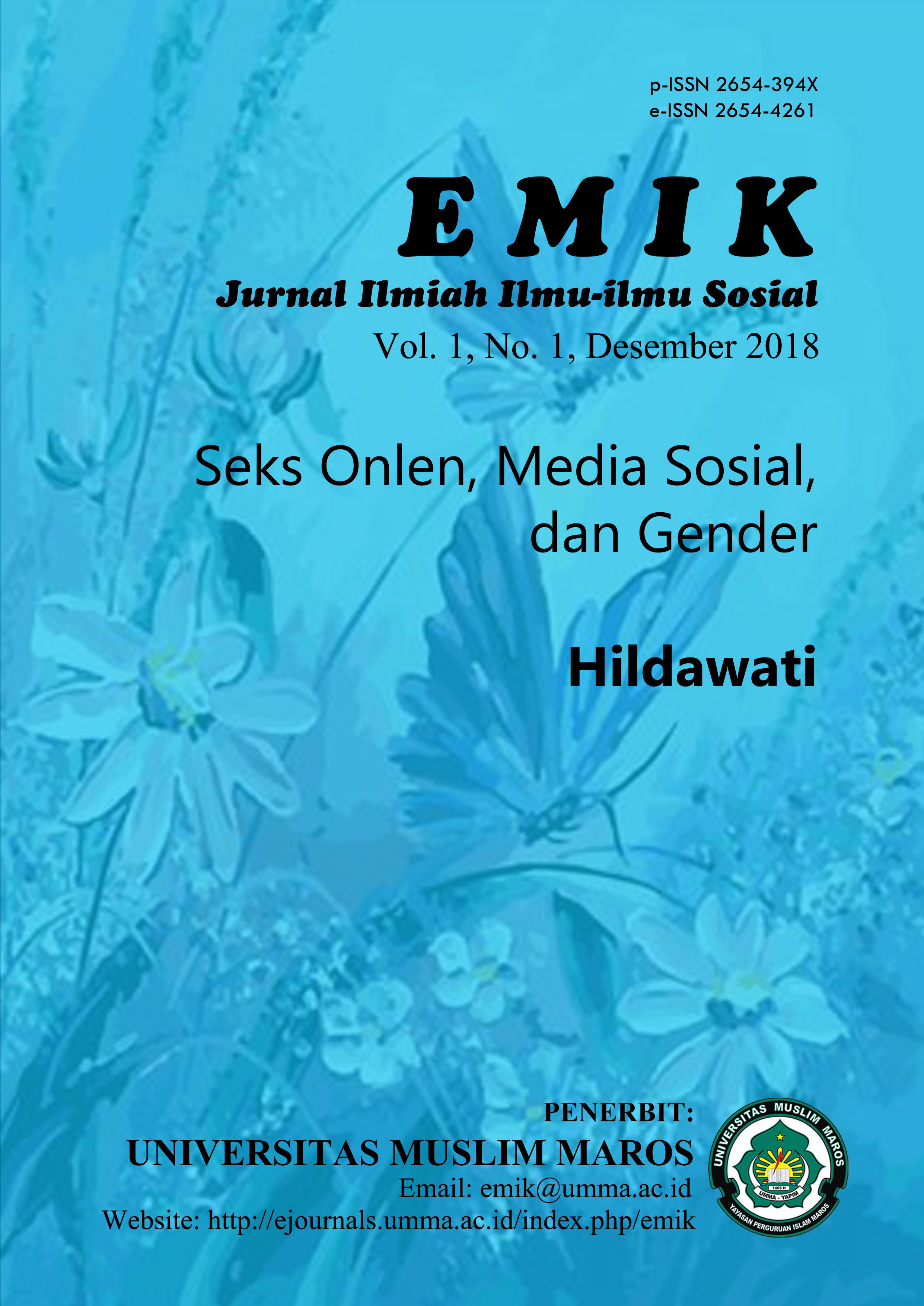Seks Onlen, Media Sosial, dan Gender
Keywords:
Sex, Online, Social Media, Instagram, Whatsapp, GenderAbstract
Normatively sexual relations are carried out directly by a pair of different sexes. However, now sex can be done in various ways, including by using communication technology to be able to have sex without physical contact and long distance, which is known as online sex. The research setting is focused on social media in the form of online sex service provider accounts. Fifteen participants get involved in this study, who offered their online sex service. I combined in-depth interview and observation as my data collection techniques. The study shows that online sex is different based on the type of technology used and can be categorized into three types, namely VCS (video call sex), PS (phone sex), and CS (chat sex). While VSC online sex is carried out through feature video call, PS online sex is carried out through voice telephone conversations, and CS online sex is done through chatting on social media Instagram or Whatsapp. Online sex providers use Instagram accounts not only as a medium to promote online sex services, but also as a media to find prospective online sex customers. The objective orientation between female online sex providers and male online sex service providers shows differences based on gender. Making money is the primary objective of of female sex online providers, while for male service providers, seeking sexual satisfaction is their primary objective with a slogan "we are equally satisfied". But, some customers can have their services for free as long as they both agree, others ask to have video or nude photo from their customers. Online sex is carried out not only in the form of sighing, speaking vulgarly, looking naked (either half naked or full body), to masturbating. This can also be continued with non-online sex through booking out (BO), depending on the agreement between sex online provider and the customer or between sex online service providers. It is argued in this article that social media has become a medium not only to run one’s business, but also to have online sex.
References
Adiarsi, G.C.; Stellarosa, Y,; dan Silaban, M.W. 2015. “Literasi Media Internet Di Kalangan Mahasiswa”. Jurnal Humaniora, 6(4):470-482.
Amila, A. dan Diyah, U.. 2014. “Rasionalitas Phone Sex Waria Di Sidoarjo”. Jurnal Paradigma, 2(3):1-11.
Bauermeister, J. A., Yeagley, E., Meanley, S., & Pingel, E. S. 2014. “Sexting among Young Men Who Have Sex with Men: Result from a National Survey”. Journal of Adolescent Health, 54:606-611.
Brandon T. McDaniel and Michelle Drouin. 2015. “Sexting Among Married Couples: Who Is Doing It, and Are They More Satisfied?”, Cyberpsychology, Behavior, and Social Networking, 18(11): 628-634.
Delevi, R., dan Weisskirch, R. S. 2013. “Personality Factors as Predictors of Sexting”. Computers in Human Behavior, 29:2589-2594.
Drouin, M. 2015. “Sexual Communication in the Digital Age”, in Rosen, L.D.Cheever, N.A. dan Carrier, L.M. (ed.), the Wiley Handbook of Psychology, Technology and Society. Chichester: Wiley-Blackwell, 176-191.
Drouin, M., dan Tobin, E. 2014. “Unwanted But Consensual Sexting among Young Adults: Relations with Attachment and Sexual Motivations”. Computers in Human Behavior, 31:412-418.
Drouin, M., Vogel, K. N., Surbey, A., dan Stills, J. R. 2013. “Let’s Talk about Sexting, Baby: Computer-mediated Sexual Behaviors among Young Adults”. Computers in Human Behavior, 29:A25-A30.
Gomez, L. C., dan Ayala, E. S. 2014. “Psychological Aspects, Attitudes and Behaviour Related to the Practice of Sexting: A Systematic Review of the Existent Literature”. Procedia Social and Behavioral Sciences, 132:114-120.
Hidayati, V. F. 2015. Analisis Hukum Islam Terhadap Layanan Phone Sex. Skripsi. Surabaya: Universitas Islam Negeri Sunan Ampel.
Hildawati. 2018. “Haters di Instagram: Antara Meluapkan Kebencian dan Memeroleh Keuntungan”. Etnosia, 3(1):22-47.
Khotimah, Khusnul. 2017. Hubungan Antara Kepuasan Seksual Dengan Kebahagiaan Pernikahan Pada Dewasa Madya. Skripsi. Surabaya: Universitas Islam Negeri Sunan Ampel.
Klettke, B.; Hallford, H. J.; dan Mellor, D. J. 2014. “Sexting Prevelance and Correlates: A Systematic Literature Review. Clinical Psychology Review, 34:44-53.
Krickic, D.; Sincek, D.; dan Cike, A.B. 2017. “Sexting, Cyber-violence and Sexually Risk Behaviour Among College Students”. Criminology and Social Integration Journal, 25(2):15-28.
Raharjo, W.; Saputra, M.; dan Hapsari, I.. 2015. “Harga Diri, Sexting dan Jumlah Pasangan Seks yang Dimiliki oleh Pria Lajang Pelaku Perilaku Seks Berisiko”. Jurnal Psikologi, Agustus, 42(2):101-114.
Raisa. 2016. A Brief History of Instagram’s Fateful First Day, http://time.com/4408374/instagram-anniversary/diakses tanggal 15 Oktober 2018.
Sakinah. 2018. “Selebgram: Meraih Popularitas Melalui Dunia Maya”. Etnosia, 3(1):48-71.
Weisskirch, R. S. 2013. “Personality factors as predictors of sexting”. Computers in Human Behavior, 29:2589-2594.
West, J. H., Lister, C. E., Hall, P. C., Crookston, B. T., Snow, P. R., Zvietcovich, M. E., dan West, R. P. 2014. “Sexting among Peruvian Adolescents”. BMC Public Health, 14:811-818.










9.png)















